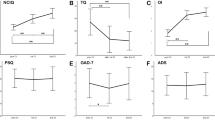Abstract
Purpose
A speech discrimination score (SDS) is a predictor for the successful use of hearing aids (HAs). This study is to evaluate the efficacy of HAs in patients with a low or poor SDS.
Methods
We enrolled 186 ears using HAs, with an unaided SDS ≤ 64%. They were categorized into four groups by their unaided SDS: 0–16% for Group 1, 20–32% for Group 2, 36–48% for Group 3, and 52–64% for Group 4. Aided SDS was measured 1, 3, 6, and 12 months after the use. The Hearing In Noise Test (HINT), the Hearing Handicap Inventory for the Elderly (HHIE), and the International Outcome Inventory for Hearing Aids (IOI-HA) were assessed.
Results
The SDS increased by 27.4% (12.0 to 39.4%) in Group 1, 26.4% (26.9 to 53.3%) in Group 2, 24.6% (42.2 to 66.8%) in Group 3, and 10.5% (59.5% to 70.0%) in Group 4. HINT composite scores significantly decreased from 22.5 to 15.1 in Group 1, 9.4 to 7.0 in Group 2, and 4.4 to 2.4 in Group 4. Total HHIE score changed from 48.2 to 24.2 in Group 1, 64.0 to 32.8 in Group 2, 37.1 to 16.6 in Group 3, and 55.8 to 40.1 in Group 4 (P < 0.05 in Groups 2, 3, and 4).
Conclusion
In patients with a low SDS, a significant increase in SDS was achieved after the use of HAs, and subjective satisfaction was also acceptable. Low SDS might not be a contraindication for HAs.





Similar content being viewed by others
References
Vos T, Allen C, Arora M et al (2016) Global, regional, and national incidence, prevalence, and years lived with disability for 310 diseases and injuries, 1990–2015: a systematic analysis for the Global Burden of Disease Study 2015. Lancet 388(10053):1545–1602. https://doi.org/10.1016/S0140-6736(16)31678-6
Kamil RJ, Lin FR (2015) The effects of hearing impairment in older adults on communication partners: a systematic review. J Am Acad Audiol 26(2):155–182. https://doi.org/10.3766/jaaa.26.2.6
Mick P, Kawachi I, Lin FR (2014) The association between hearing loss and social isolation in older adults. Otolaryngol Head Neck Surg (United States) 150(3):378–384. https://doi.org/10.1177/0194599813518021
Rubel EW, Furrer SA, Stone JS (2013) A brief history of hair cell regeneration research and speculations on the future. Hear Res 297:42–51. https://doi.org/10.1016/j.heares.2012.12.014
Chien W, Lin FR (2012) Prevalence of hearing aid use among older adults in the United States. Arch Intern Med 172(3):292–293. https://doi.org/10.1097/IPC.0b013e31822e9bba.I
Moon IJ, Baek SY, Cho YS (2015) Hearing aid use and associated factors in South Korea. Medicine (Baltimore) 94(42):e1580. https://doi.org/10.1097/MD.0000000000001580
Moon SK, Lee JW, Choung YH, Park K (2015) Clinical analysis of hearing aid failure. Korean J Otolaryngol 48(1):13–17
Abdellaoui A, Tran Ba Huy P (2012) Success and failure factors for hearing-aid prescription: results of a French national survey. Eur Ann Otorhinolaryngol Head Neck Dis 130(6):313–319. https://doi.org/10.1016/j.anorl.2012.09.014
Lopez-Poveda EA, Johannesen PT, Pérez-González P, Blanco JL, Kalluri S, Edwards B (2017) Predictors of hearing-aid outcomes. Trends Hear 21:1–28. https://doi.org/10.1177/2331216517730526
Hodgson WR (1986) Hearing aid evaluation and use in audiologic habilitation. Williams & Wilkins, Baltimore, pp 152–169
Dillon H (2012) Hearing aids. Thieme, New York, p 263
Hong NP (1998) Hearing aid candidacy and selection criteria. Korean J Audiol 2(1):10–16
Pekkarinen E, Salmivalli A, Suonpää J (1990) Effect of noise on word discrimination by subjects with impaired hearing, compared with those with normal hearing. Scand Audiol 19(1):31–36
Helfer KS (1992) Aging and the binaural advantage in reverberation and noise. J Speech Hear Res 35(6):1394–1401. https://doi.org/10.1044/jshr.3506.1394
Ventry IM, Weinstein BE (1982) The hearing handicap inventory for the elderly: a new tool. Ear Hear 3(3):128–134. https://doi.org/10.1097/00003446-198205000-00006
Lazard DS, Vincent C, Venail F et al (2012) Pre-, per- and postoperative factors affecting performance of postlinguistically deaf adults using cochlear implants: a new conceptual model over time. PLoS ONE 7(11):1–11. https://doi.org/10.1371/journal.pone.0048739
Funding
The authors have no funding or financial relationship to declare.
Author information
Authors and Affiliations
Corresponding author
Ethics declarations
Conflict of interest
The authors declare that they have no conflict of interest.
Ethical approval
All procedures performed in studies involving human participants were in accordance with the ethical standards of the Institutional Review Board of Ajou University Hospital (AJIRB-MED-MDB-19–214) and with the 1964 Helsinki declaration and its later amendments or comparable standards.
Informed consent
The requirement for informed consent was waived by the Institutional Review Board of Ajou University Hospital.
Additional information
Publisher's Note
Springer Nature remains neutral with regard to jurisdictional claims in published maps and institutional affiliations.
Electronic supplementary material
Below is the link to the electronic supplementary material.
Rights and permissions
About this article
Cite this article
Kim, H., Choo, OS., Park, K. et al. Hearing aids are still beneficial to patients, even if they have a low speech discrimination. Eur Arch Otorhinolaryngol 277, 2987–2994 (2020). https://doi.org/10.1007/s00405-020-06018-3
Received:
Accepted:
Published:
Issue Date:
DOI: https://doi.org/10.1007/s00405-020-06018-3




